Construction of houses from aerated concrete

Nowadays, the range of building materials is greater than ever. You can build a house not only from wood or brick, but also from all sorts of blocks. Some of the most popular today are aerated concrete blocks, which have many positive qualities. Today we will analyze in detail how to build a house from this demanded material.
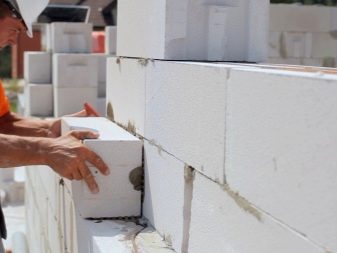
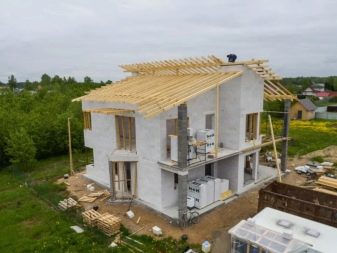
Advantages and disadvantages
Currently, on the streets you can find a huge number of block houses of various modifications. These can be both small and modest buildings, and luxurious buildings of several floors. Various materials are used for the construction of such objects. Most often, of course, there are houses made of aerated concrete or foam concrete blocks. It is difficult to confuse these materials with something, since they have a characteristic appearance recognizable by most people.
These building materials are not in vain so popular. Their relevance is due to a large list of positive qualities that are inherent in them.
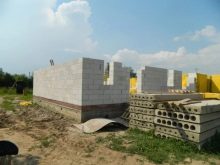
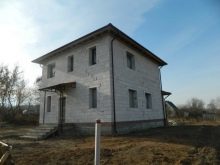
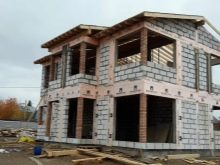
Let's get acquainted with all the advantages of aerated concrete blocks:
- This material has good thermal insulation characteristics. Most managers focus on this quality when selling aerated concrete.
- Another important advantage that attracts most of today's consumers is the affordable price.
- A distinctive feature of aerated concrete blocks is their density. This parameter can be 400-1200 kg / m3.
- These building materials boast resistance to moisture and moisture. Even with a high level of air humidity, the indicators of the blocks themselves will be low.

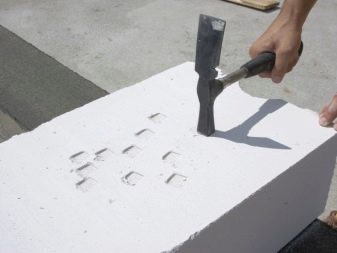
- It is impossible not to mention that aerated concrete is a fire-safe raw material. It is not only not susceptible to ignition, but also does not support an already kindled flame. This characteristic is especially relevant when building a reliable and durable house / summer residence.
- Aerated concrete is not afraid not only of fire, but also of low temperatures. Due to this characteristic, a gas block house can be built even in a harsh climate. Under the influence of minus temperature values, this material does not lose its positive properties, does not collapse and does not undergo deformation.
- Aerated concrete is resistant to biological effects. Buildings, for example, made of wood, cannot boast of this parameter. Due to this quality, gas-block houses do not need to be treated with special protective compounds and powerful antiseptics. Insects or rodents do not start in aerated concrete.
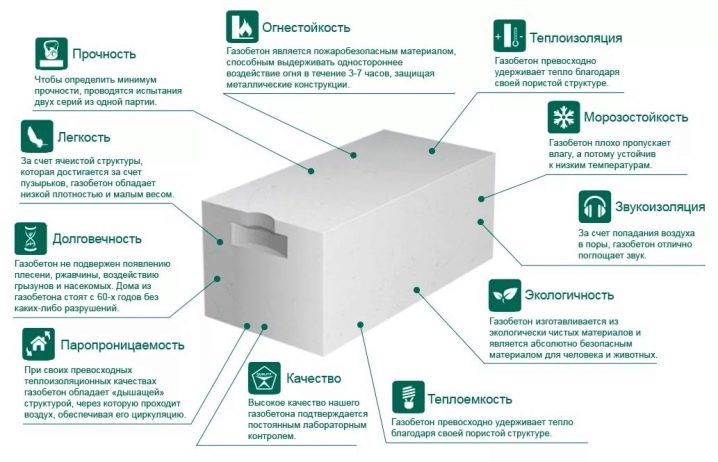
- Aerated concrete is a durable material. Houses from it can stand for more than a century.
- The material is environmentally friendly. It contains no dangerous and harmful chemicals that can harm the health of households. According to experts, only natural wood can compete in environmental friendliness with aerated concrete.
- Aerated concrete blocks boast good sound insulation characteristics. In houses made of such material, there is no unnecessary noise coming from the street.
- Aerated concrete is a fairly strong and reliable material. If you supplement it with high-quality reinforcement, you can build a large house with several floors.
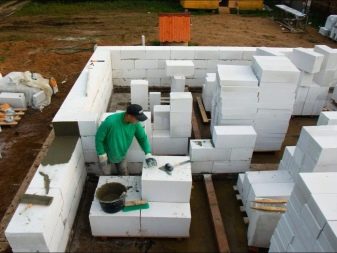
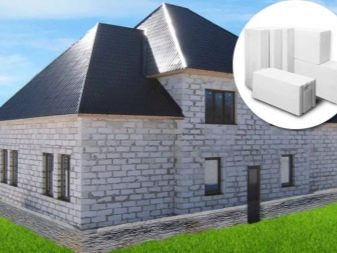
- Many craftsmen claim that aerated concrete is a very malleable material that can be easily processed.Thanks to this feature, aerated concrete blocks can be cut without problems if necessary. Here it is worth considering only one nuance: in the wall ceilings made of aerated concrete, the dowels are not very tight, so instead of them it is better to use special self-tapping screws.
- In the course of the manufacture of aerated concrete, a small amount of cement leaves.
- Aerated concrete blocks are lightweight, which explains the ease of working with these materials, as evidenced by the reviews of the owners of block houses.
- Aerated concrete blocks are characterized by a special structure with cells. Thanks to this distinctive feature, materials can be easily moved from one place to another without the need for a crane.
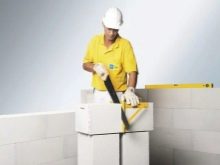
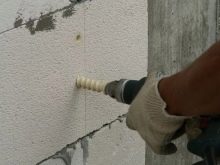
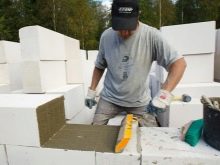
- Gas-block houses are built using a special adhesive that perfectly replaces cement mortar. It is easier to work with it, and it does not create cold bridges.
- Few people know that aerated concrete can be used to build not only cottages, but also reliable, strong multi-storey buildings. This inexpensive and popular material is versatile. It can be used to make all sorts of outbuildings, closed fences, steps and even elements such as flower beds, gazebos or fireplaces.
- This material boasts excellent vapor and air permeability characteristics. Experts say that in aerated concrete houses, air circulation and the percentage of humidity are regulated in a natural way, ensuring a comfortable microclimate inside the home.
- Today, these materials are manufactured by many manufacturers in the factory using high-tech equipment. Such gas blocks are subject to strict quality control at all stages.
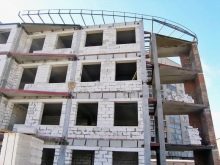
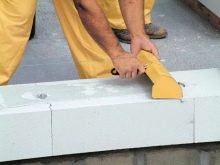
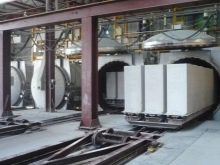
Aerated concrete, like any other material for construction, has its drawbacks.
Let's get acquainted with them:
- The main negative quality of gas blocks is their high hygroscopicity.
- If the foundation structure for a gas-block house was made with any violations, then large and noticeable cracks can form on the buildings. Moreover, this damage usually occurs not only on the masonry lines, but also on the blocks themselves. As for microcracks, they appear on these parts after 2-4 years.
- Of course, gas blocks form an optimal humidity level in the room, however, after a while, moisture begins to accumulate in such materials. This fact can ultimately lead to dampness of the blocks, and then their stratification.
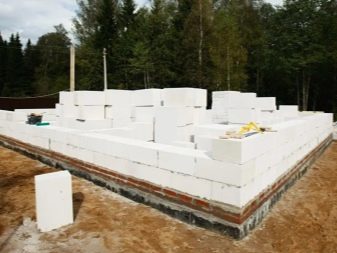
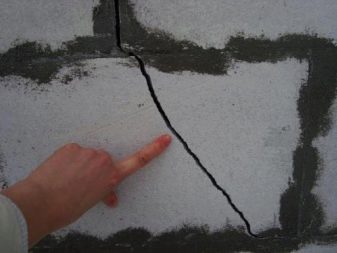
- The thermal insulation characteristics of foam blocks, of course, are not bad, but the same cheap foam blocks are ahead of them in this matter.
- If you built a house from gas blocks, then in the end you will definitely need to decorate it. Most modern manufacturers declare that buildings made of such a material will stand for several years without facing, but we must not forget that aerated concrete is a material that absorbs moisture into its structure, after which it gives it back and absorbs it again and again. Over time, the building will take on an ugly appearance, and it will be damp inside the blocks.
- When decorating gas blocks inside the home, certain problems may arise. For these substrates, it is recommended to purchase a special gypsum-based plaster. Yes, it has excellent adhesion properties, but under conditions of sharp temperature jumps, such walls may develop cracks that follow the contours of the masonry.
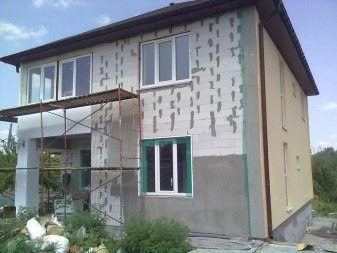
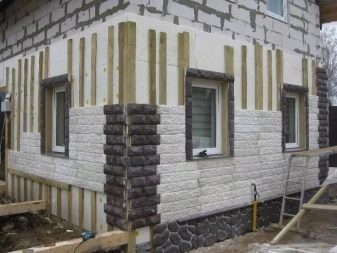
Design
Many consumers believe that only a simple and unremarkable house can be built from aerated concrete blocks. In fact, it is quite possible from this material to build a very original and spectacular building that will attract the attention of neighbors and passers-by. The main thing is to correctly draw up a plan and diagram of the future structure. Let's get acquainted with some interesting projects of private houses made of aerated concrete.
This popular material will make a very stylish and modern home with an attic and basement floors. A separate entrance from the street should be located on the basement floor. In such conditions, it will be possible to provide space for two cars, as well as home laundry. On the basement floor there is a place for a small boiler room. To access the basement floor, an internal additional staircase must be installed.
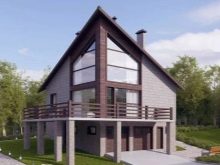
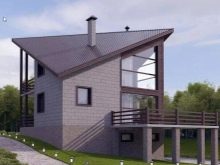
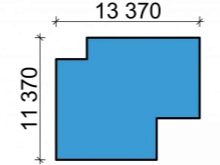
The first floor will look especially rich and stylish if decorated with chic panoramic windows. On this territory, a spacious living room, a kitchen, a combined bathroom and a dressing room, complemented by a small window, should be placed. A terrace with supporting columns will find its place at the entrance.
As for the second floor, here you can equip two small but cozy bedrooms, as well as a shared bathroom. From one of the bedrooms you should make an exit to a small balcony. A similar two-story house with a plinth will look very interesting if you give it an angular shape and repeat it on a non-standard gable roof.


If you are planning to build a neat and bright country house, then you are most likely interested in the next project.
In a building with an area of 274 sq. m you can equip the following premises:
- garage;
- closed terrace;
- 2 bathrooms;
- wardrobe;
- living room;
- kitchen.
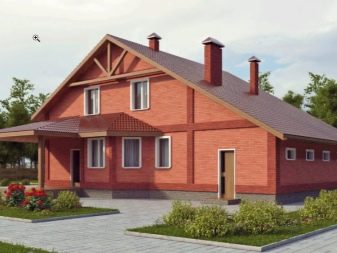
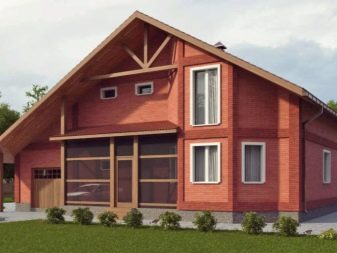
A large fireplace can be installed in the spacious, comfortable living room. Between the living room and the kitchen there is a nice bay window that can accommodate a round dining table. From here you can enjoy the views of the site.
As for the second floor, there are planned three bedrooms. Two of them should be equipped with dressing rooms, thanks to which it will be possible to significantly save useful space, because the need for bulky and roomy wardrobes with such structures will simply disappear. Quite a lot of guests will be able to accommodate in such a house, so it is better to equip 2 bathrooms on the second floor. If you want, one of them can be converted into a sauna or utility room. This cozy and welcoming house with an attic, terrace, garage and bay window can be finished with red brickwork combined with wooden beams. It is better to make the roof a simple gable. This English-style building will radiate warmth and comfort when surrounded by small flower plantings.
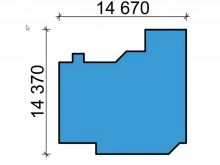
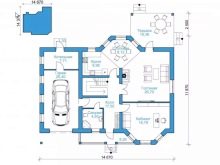
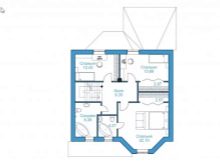
If you want to build a small but beautiful and cozy house with dimensions of 10x10 and an area of no more than 100 sq. m, you should consider the project of a one-story building of the correct square shape.
In such a building will find their place:
- a spacious living room, separated from the kitchen by a small partition;
- three bedrooms located directly opposite the kitchen and living room;
- the bathroom and the bathroom should be located behind a partition that separates them from the kitchen;
- the hall can be located between the bathroom and the very first bedroom, located on the left side immediately from the front door.
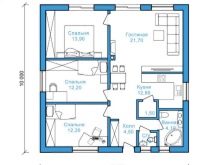
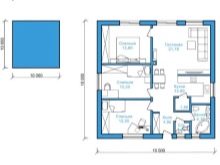
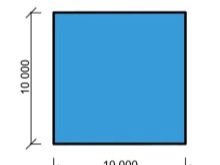
An open parking space should be equipped in front of such a compact house. For outdoor decoration, it is better to use light-colored materials that will not visually make the structure even smaller. Play on contrasts - consider a gable roof with hard tiles in dark gray or black. In the backyard behind the house, equip a small canopy, place tables and chairs under it, and organize a small square pool to the side.
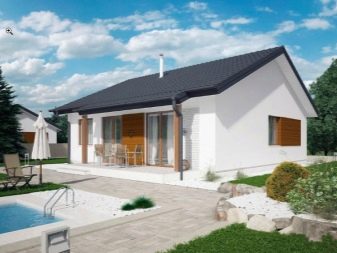

Choosing a foundation
For a house made of aerated concrete, you need to build very reliable foundations. If we are talking about a soil that is not prone to heaving, you can turn to a simple tape option. Such a foundation is chosen most often, since it is quite simple to build, but at the same time it is quite strong. As for the depth, it must necessarily be lower than the level of soil freezing.Because of its design, the tape's reinforcement will compensate for any stresses caused by heaving.
If the depth of soil freezing is 2 m or more, then a strip-type foundation may be too expensive. In such a situation, when the soil is buried at this level, a pile foundation with a grillage is usually built. There is no way to do without it. The grillage will be responsible for compensating for uneven movements, which quite often appear on a pile-type foundation structure.
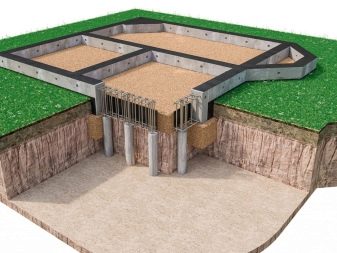
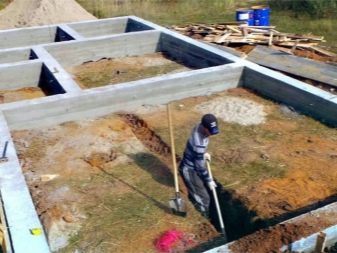
One pile is often lifted a little more and the other a little less. If you do not build a grillage, this will lead to the formation of cracks. For this reason, the organization of the grillage is mandatory if the walls of the house are made of aerated block.
The most high-quality option for a foundation that will be resistant to damage is the option in the form of a monolithic slab. Of course, it will cost more than the above options, but with it the gas-block house will not undergo defects. Typically, such a base is equipped on soils with a low bearing capacity, for example, peat bogs or fine-grained loose sands.
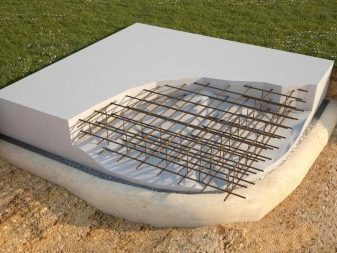
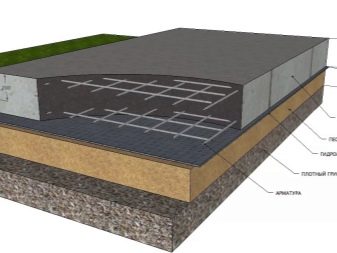
As a result, it may turn out that the monolithic option will cost less in such conditions than the strip foundation at a depth of more than 2 m.In this situation, the monolith is more expedient if, due to the peculiarities of geology, it will not be possible to build a pile structure.
It is not recommended to make a prefabricated foundation for a gas-block house. Most often, problems arise when foundations are made of bricks or building blocks. Since the listed materials themselves are susceptible to cracks, together with cellular aerated concrete, this can turn into a rather serious problem: it will be almost impossible to avoid cracking, and this will negatively affect not only the appearance of the house, but also its reliability. That is why prefabricated foundations in the manufacture of gas-block houses should be abandoned.
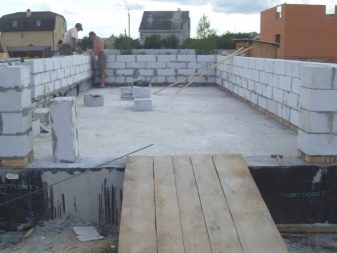
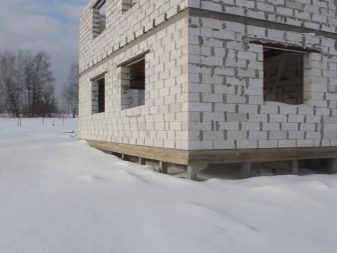
Do not forget that with the question of which foundation is 100% suitable for an aerated concrete house, it is better to contact experienced designers who have the results of geological studies of your site.
How to build?
Gas-block houses are good not only for their durability and reliability, but also for their relative ease of construction. If you want to build such a dwelling with your own hands, then you should follow the detailed step-by-step instructions so as not to face many of the problems encountered by inexperienced builders.
Let's consider in stages how to put a gas-block house without resorting to the help of professional craftsmen.
To carry out construction work, you will need the following tools:
- band saw;
- drill;
- hand saw;
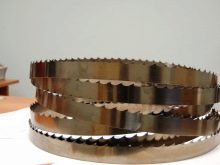
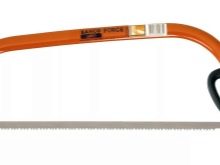
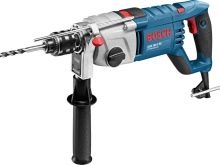
- wall chaser;
- mixer;
- electric cutter;
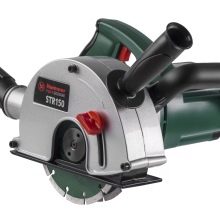
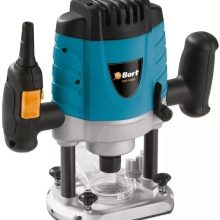
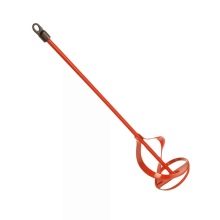
- scraper bucket;
- hacksaw;
- grater;

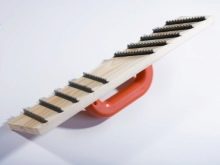
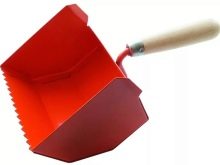
- necessary fasteners;
- glue carriages;
- trowel with teeth;
- rubber hammer;
- sanding board.
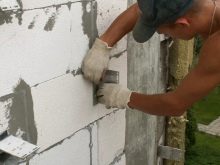


The first step is to build a high-quality and reliable foundation. Before starting work with this foundation, you need to thoroughly clear the area. Remove all unnecessary and go to the markup.
To do this, you need to use reinforcement rods and a special lace or rope. First, you should determine the axis of the planned structure. Take a plumb line and mark the first corner of the foundation structure. Extend the rope to 2 and 3 corners perpendicular to the first mark.
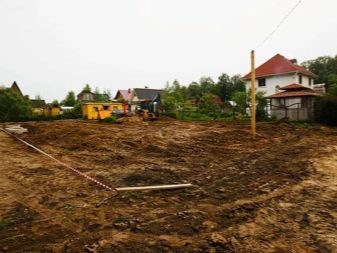
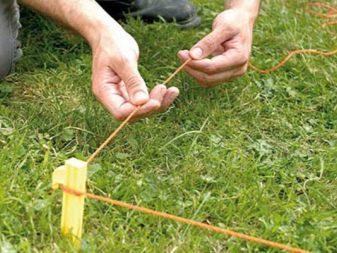
Next, you need a square. Use it to mark the 4th corner. Take measurements diagonally. If the length parameter turned out to be the same, then this means that everything is going according to plan and you can proceed to installing the rods and then tightening the rope.
In the same way, it is necessary to carry out the internal marking of the base.In this case, it is important to indent from the outer base (about 400 mm). As for the trench, it must be dug both along the perimeter of the planned dwelling, and under the future internal wall ceilings.
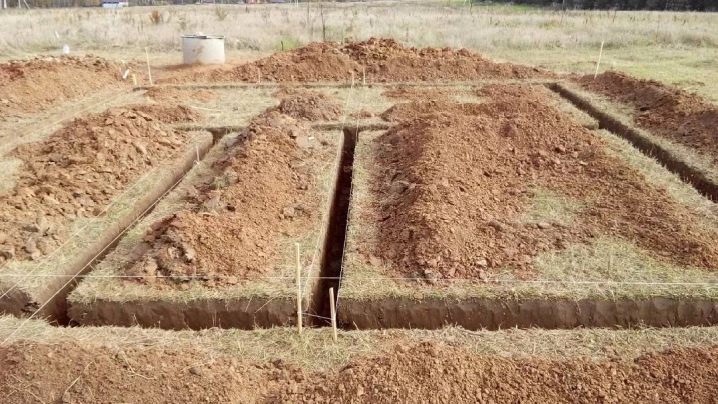
Next, you need to competently prepare the trench. Find the lowest possible point on your site. Count the depth of the hole from it. It is permissible to build a small house on a 40 cm tape.
In other matters, it is necessary to rely on the design features of the structure and site. Consider the degree and point of soil freezing and the location of groundwater. After that, you can proceed to digging a trench. Please note that the walls of the pit should be exclusively vertical and the bottom should be flat. To check these parameters, you need to use a level and a plumb line.
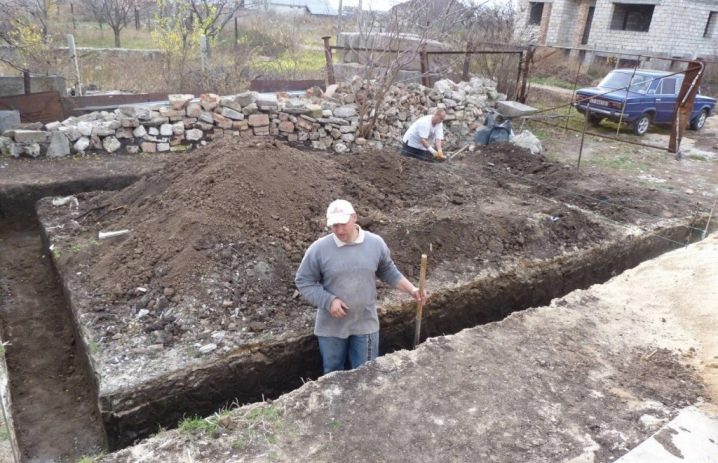
A sand pillow should be placed on the bottom of the dug trench. Tamp it down well. This component will be responsible for the optimal distribution of the load on the base during the change of seasons. It is advisable to make a pillow 15 cm thick. Sprinkle rubble on the sand and lay sheets of roofing material.
The next step is to assemble the formwork. It can be built from planks, plywood sheets and other similar materials. The details of the formwork must be fastened together with nails or screws. Along the perimeter inside this structure, it is necessary to stretch the fishing line at the level of the surface of the future fill.
At this stage, you need to think over the location of the holes for the water supply and sewer system. For this purpose, empty pipes are usually placed in the right places, after which they are filled with a sand mixture.
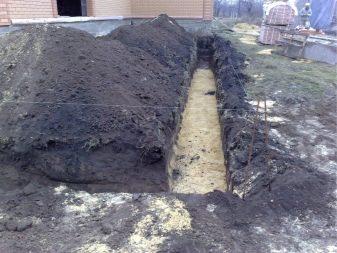
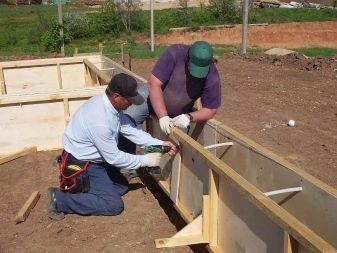
Now we turn to the laying of the reinforcement parts. Take rods with a diameter of 12-14 mm. Tie them into a mesh using steel wire. The grid cells can be of different sizes. The heavier the structure is, the more compact the side of the square should be.
As a rule, there are enough cells with a size of 20x20 cm. The mesh must be made in accordance with the dimensions of the dug trench. Please note that between the laid out layer of reinforcement and the top of the trench, you need to leave 5 cm indents. They will come in handy so that the reinforcement is subsequently accurately filled with concrete.
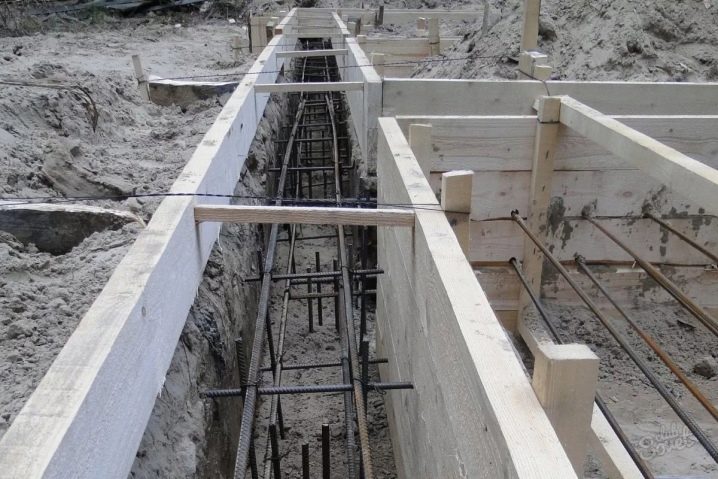
The next step is to pour the concrete. We multiply the width of the foundation structure by its length and height. Thus, the required volume of concrete solution is determined. Prepare or order a quality mixture.
If you decide to prepare this solution yourself, then you should stick to the old and proven recipe:
- take 1 part of cement;
- 5 pieces of crushed stone;
- 3 pieces of sand;
- water in the amount required to provide the required consistency.
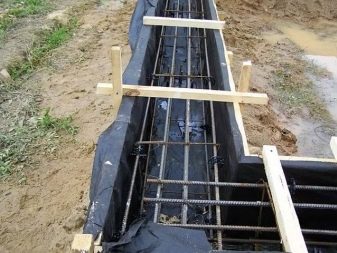
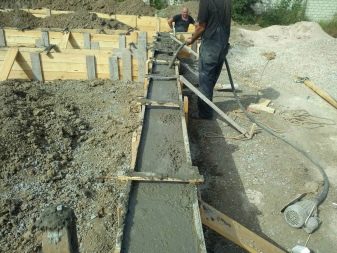
Pour the resulting composition evenly, in layers of 200 mm. In this case, do not rush, thoroughly tamp each layer. Pour the concrete solution up to the level of the pre-exposed rope in the formwork.
Be sure to level the pouring surface using a trowel. Pierce the concrete layer with reinforcement at several points. Gently tap the outside of the formwork with a hammer.
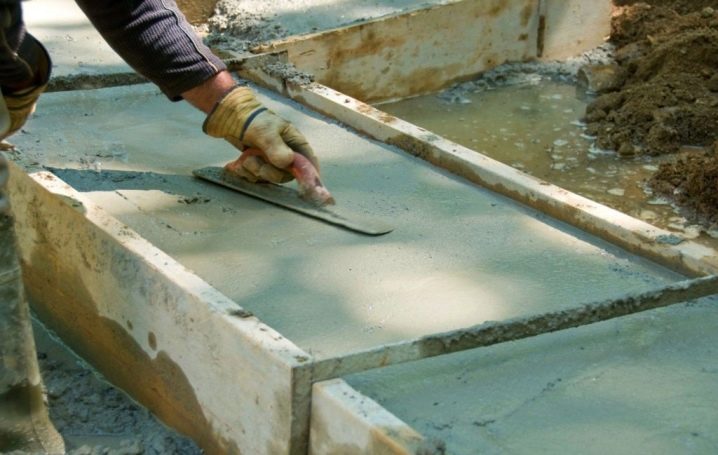
For the foundation to gain strength, it will take at least a month. For this period of time, it is necessary to close the structure with plastic wrap to ensure protection from atmospheric precipitation. In hot weather conditions, you need to water the structure with water so that it does not crack. As for the formwork, it should be removed no earlier than 10 days after pouring. Many experts recommend leaving it for a month.
Then you can proceed to the design of wall surfaces. For their construction, it is recommended to use gas blocks, the design of which is made according to the type of thorn-groove system. Working with such elements is easy and simple. Of course, you can use any other materials. From this, the technology of building a house will not change in any way.
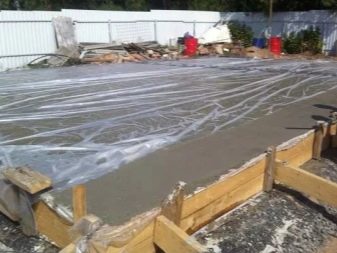
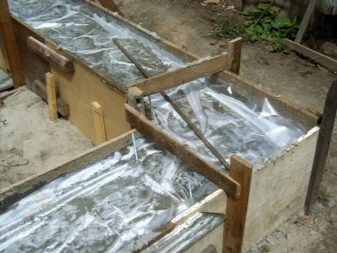
You can start laying the first row of aerated concrete blocks.For its installation, it is recommended to use a sand-cement mortar, and not a special glue. Of course, it will take longer to dry, but you can adjust the evenness of the starting block masonry.
The minimum layer thickness is 10 mm. There are practically no upper limits. Thanks to this fact, you can smooth out all the drops without any problems.
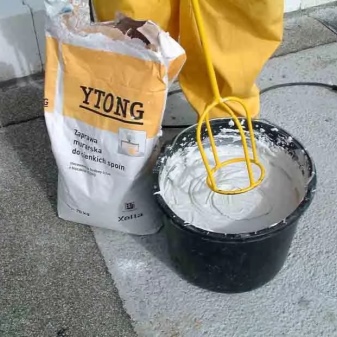
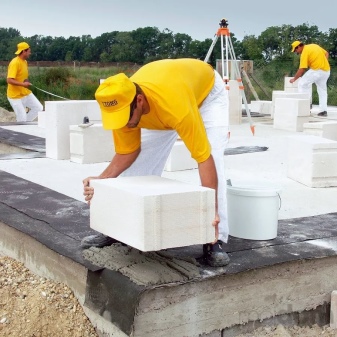
Find the highest angle possible. You need to start the construction from him. Take the fishing line and outline the wall surfaces of the dwelling. After that, you can lay the starting aerated concrete block.
Next, you should put a block on each of the remaining corners and stretch the rope between the individual elements. In the process, do not forget to check the evenness of the laying of each gas block. Lay out the first row around the perimeter of the future structure, as well as in the areas for the manufacture of internal walls.
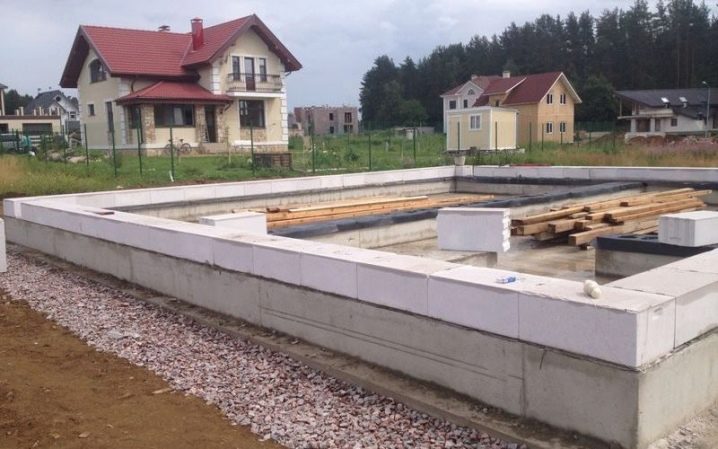
Next, you can lay 2 and 3 rows. First you need to take a polish and grind the top of the first row. In the future, you will need to act in the same way with all the rows laid. Due to this treatment, you will be able to apply the adhesive layer more evenly.
Then you can lay the subsequent rows. In this case, you should use a special adhesive composition designed specifically for aerated concrete masonry. You need to act according to the same principle as when installing the starting row - start from the corners. The rows will need to be tied up, shifting half the block, as is the case with brickwork. The smallest parameter for such a shift is the 80 mm mark.
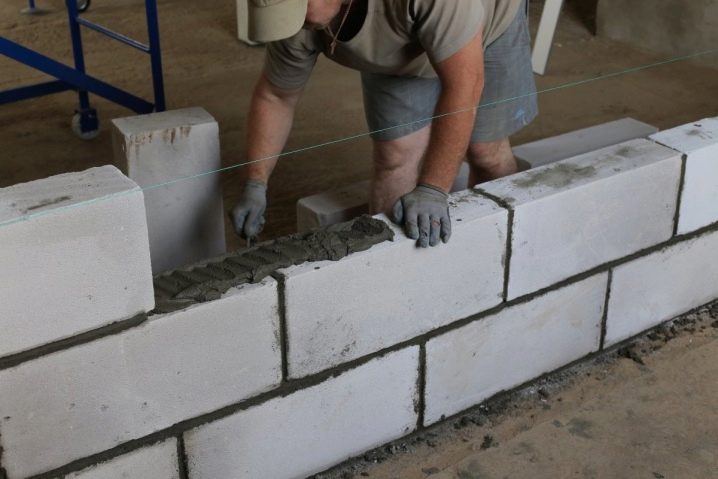
To apply the adhesive, it is recommended to use special buckets equipped with teeth. Please note that gas blocks should be placed as close to each other as possible. Slide them back to back.
Do not forget to check the evenness of the masonry with a level. If necessary, align the blocks with a rubber mallet. Work should be done at a fast pace, as it will be too difficult to move the block after the glue dries. After that, you need to build a reinforced belt between the floors.
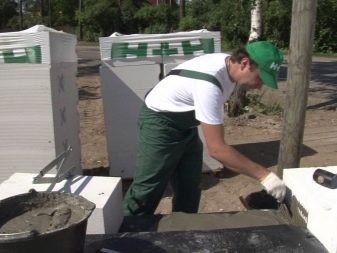

Equip windows and sills. For example, the last specified details can be 4 masonry rows in height. Openings for windows need to be reinforced by completing the installation of 3 rows. This is where a wall chaser comes in handy. In the area where the window opening will be located, you need to grind 2 parallel lines. Their length should be such that they protrude 300 mm from each side of the window. It is necessary to install reinforcement rods in the grooves and fix them with a cement-sand composition. Thus, the wall for the installation of the window structure will be ready.
You will also need to make jumpers. These components are necessary to strengthen the section of the wall located above the door and window openings. Please note that without jumpers, such structures can collapse.
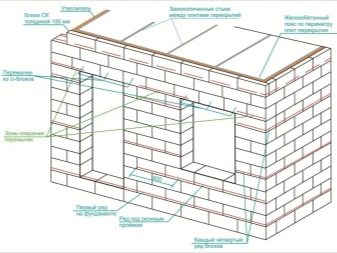
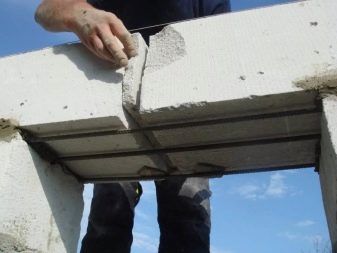
For these works, you can use ready-made U-shaped blocks. They are glued to each other in accordance with the required length, then they are installed, reinforcement is laid and poured with a cement mixture. You can also build a formwork.
To make the formwork, it is best to use aerated concrete blocks, the width parameter of which is 10 cm. To obtain such parts, it is permissible to cut an ordinary block into 3 identical pieces. Then the blocks must be glued to the required length. Make 3 longitudinal grooves with the help of a wall chaser, put reinforcement in them, fill with cement mortar and let the structure dry completely for 24 hours.
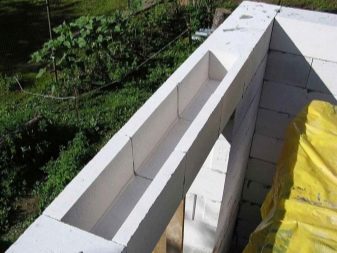
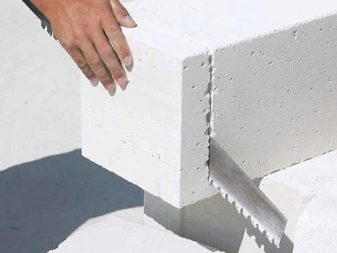
Jumpers should be installed with the reinforcing bar side down. Fill in the remaining spaces with blocks if required. For this, it is permissible to use pre-cut elements of suitable dimensions.
After completing the laying of the row with jumpers, you need to proceed to pouring the reinforced belt. This structure must be made of reinforced concrete. She will be responsible for the integrity of the aerated concrete structure.
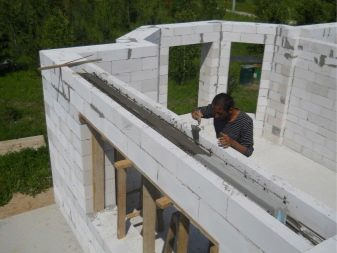
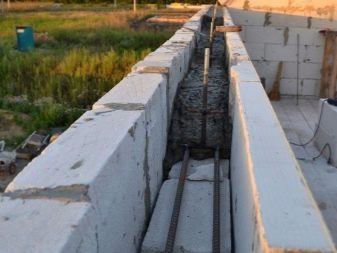
Take concrete blocks 10 cm in size, form from them formwork around the perimeter of the walls. Put reinforcement parts in the ditches, and then grout. Metal studs should be installed in the reinforcement, which will be needed to attach the Mauerlat. They can be made from fittings.
There is another good option - to put threaded rods. At this stage, the box at home can be considered complete.
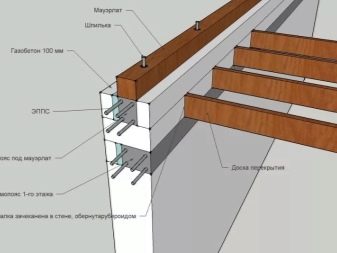

Now you can proceed to the construction of another important component of any home - the roof. Mauerlat is already ready with us, now we need to install the rafters. In this situation, the actions can be different - it is necessary to rely on the distinctive characteristics of the roofing structure you have chosen.
There are several options for homeowners to choose from.
- Roof with one slope. In residential construction, such structures are used less often. Most often, pitched roofs are installed over sheds and other outbuildings.
- With two slopes. A gable roof is quite acceptable to use in a small country house.
- Mansard, hip and other complicated designs. These types of roofs are the best options for arranging a full-fledged residential building made of aerated concrete.
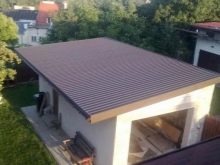
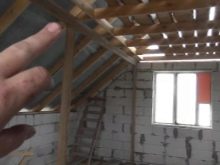
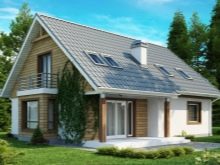
It doesn't matter what kind of roof structure you choose for your home.
In any case, it will need to be supplemented with insulating materials:
- waterproofing;
- thermal insulation;
- vapor barrier.
In some situations (for example, when it comes to arranging an attic), sound insulation is additionally installed.

A waterproofing layer should be placed on the rafters. It is best to use wooden slats for this. These parts will function as counter battens, on which the battens intended for the roof will subsequently be fixed.
Insulating material must be installed under the waterproofing layer in the gap between the details of the sheathing. Most homeowners choose mineral wool for this. Of course, you can give preference to any other material, for example, expanded polystyrene or foam. The thermal insulation material must be covered with a vapor barrier film. It must be attached to the rafters using wooden slats.
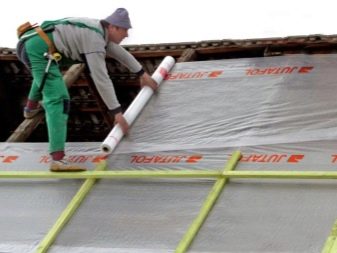
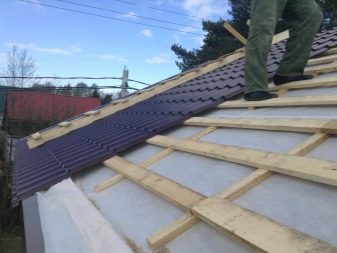
Completing all the above stages of work, you need to lay the finishing roofing. In this case, you need to focus on the budget and personal wishes.
The most demanded materials used for roof finishing are:
- bitumen-based shingles;
- slate;
- corrugated board;
- metal tiles;
- ceramic tiles.
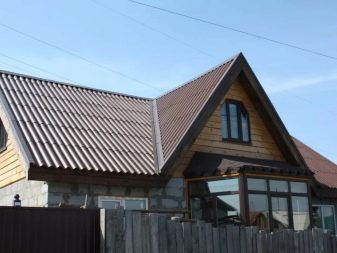
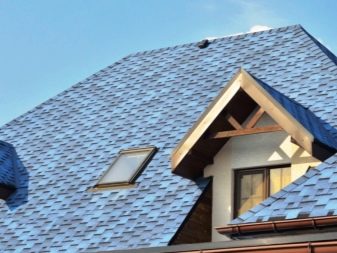
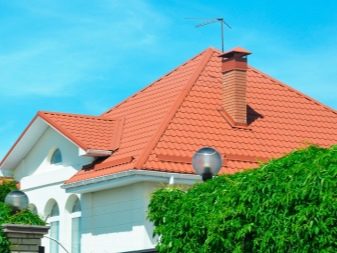
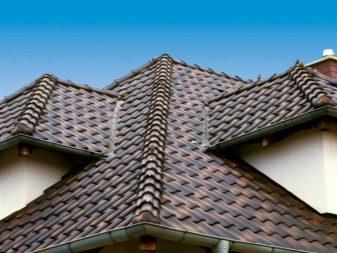
All types of roofing must be installed starting from the bottom. As a result, the sheets will become fixed in such a way that sedimentary moisture will flow down them without getting under the surface of the flooring. If you have completed all the indicated stages of construction work, then we can assume that the box and the roof of the block house are ready. In the future, you will need to deal with the installation of utilities and finishing the building.
Interior decoration
A gas-block house requires high-quality interior decoration. Fortunately, today in the stores of building and finishing materials there are a lot of reliable and durable decorative coatings that can be applied to the gas block without causing any harm to it. Finishing materials must necessarily comply with the requirements specified in GOST and SNiP.
To decorate the ceiling in such a block house, you can use the following methods:
- cover the base with plaster, and then paint or install sheets of plasterboard;
- using drywall to build various multi-level structures with built-in lamps.
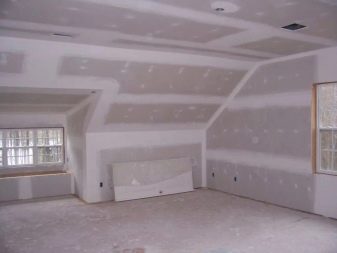
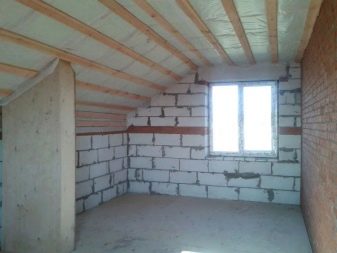
Plasterboard is attached to the ceiling base on a pre-prepared frame. Plastering in this case is not required, but insulation can be provided.
As for the walls, here, before applying the topcoat, you first need to make a high-quality leveling. It is imperative that the wall ceilings be covered with a primer and a reinforcing mesh should be laid. This is due to the fact that the adhesion characteristics of aerated concrete will not allow the finishing materials to be firmly connected together without unnecessary impact.

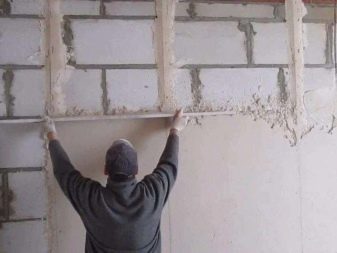
Prepared wall surfaces can be painted, wallpapered or finished with decorative plaster. It is permissible to cover some areas with a spectacular decorative stone or other similar material. You can focus on corners, window openings, or highlight certain functional areas.
Materials such as laminate, parquet or linoleum are most often laid on the floor. In the kitchen, in the bathroom and in the hallway, porcelain stoneware or ceramic tiles are mainly installed. Before laying decorative flooring materials, first install wooden logs. After that, the floor is insulated and covered with a board.
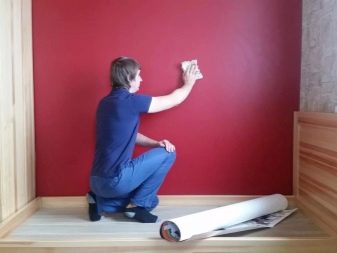
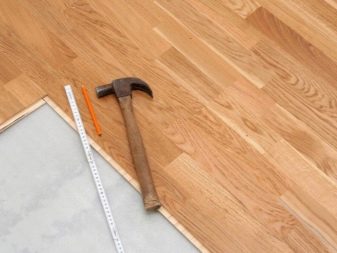
If you want to diversify the interior a little, then you can turn to the beautiful arched structures. Most often they are made from plasterboard sheets. This material can be processed without problems, therefore it is used inside a wide variety of premises. With the help of drywall, you can place a structure of almost any shape and configuration in your home.
Recommendations
- The main advice that experts give is - do not skimp on the construction of the foundation. Do not forget that a material such as aerated concrete does not tolerate any movement of the base, therefore, you need to choose a suitable structure based on the characteristics of the soil and the characteristics of the gas blocks.
- It is recommended to order the project of the future block house from the relevant organizations, since any problems and mistakes made in the documentation can lead to sad consequences. Drawings of aerated concrete buildings will determine the entire process of upcoming construction work.
- If a crack appears on the aerated concrete block, this most likely indicates shrinkage of the foundation, which was installed without observing the appropriate technology. Do not be alarmed, such material can be restored by smearing the defective areas with a gypsum mixture.
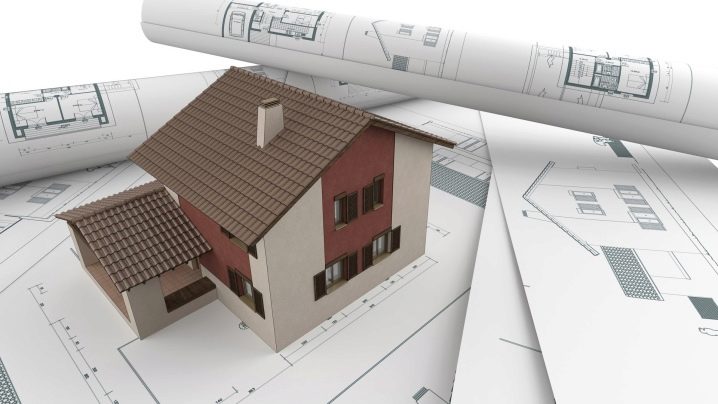
- Do not neglect the installation of the reinforcement belt. It is necessary for any house built from block materials. Thanks to this component, the building gains strength, reliability and stability.
- If, in the process of arranging the openings, you did not manage to get into the length of the whole block, you can remove the extra piece with a saw or a hacksaw for wood.
- Do not block window openings. Of course, later they can be cut out, but this will take extra time and effort, so it is better to leave these planes open.
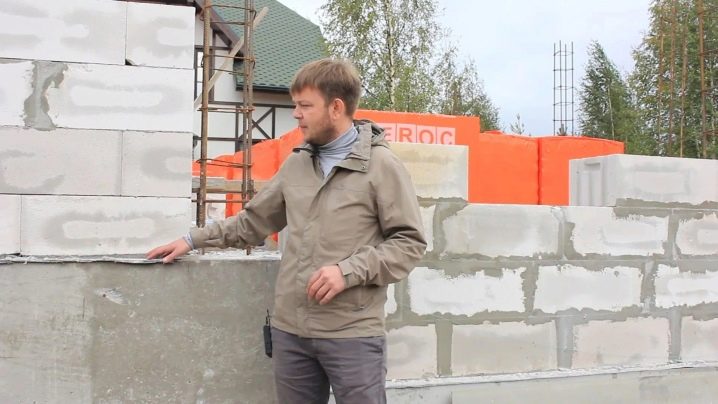
- Any facade work can be carried out only a year after the construction of the block house. In addition, the interior decoration should be completed by that time.
- If you are working with a material such as aerated concrete, then you only need to use special fasteners. Other options will not hold securely within block walls.
- To connect facing materials (for example, bricks) with supporting structures, special flexible connections are used. These parts are made of composite materials. They significantly reduce the heat loss of block houses. In addition, they are not susceptible to corrosion.
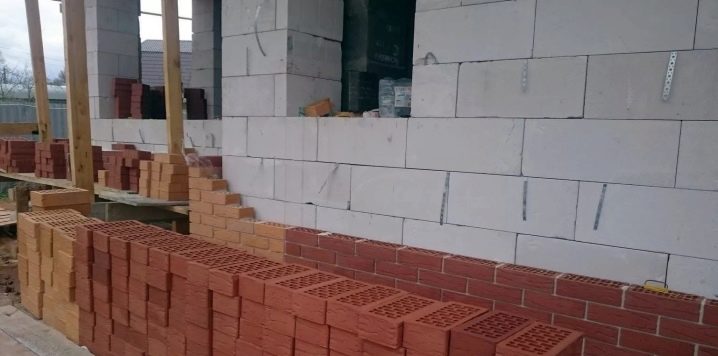
- Aerated concrete blocks should be transported carefully so as not to damage them. It is advisable to cover them with a special film to protect them from the effects of precipitation.
- If the aerated concrete blocks are correctly reinforced, then they can be used in the construction of external walls and internal partitions of various modifications.
- Do not neglect the exterior decoration of the aerated concrete house.High-quality cladding will allow not only to remove obvious and hidden imperfections of this material, but also extend its service life. Finished blocks will be more protected from negative environmental factors, which will have a positive effect on their performance.
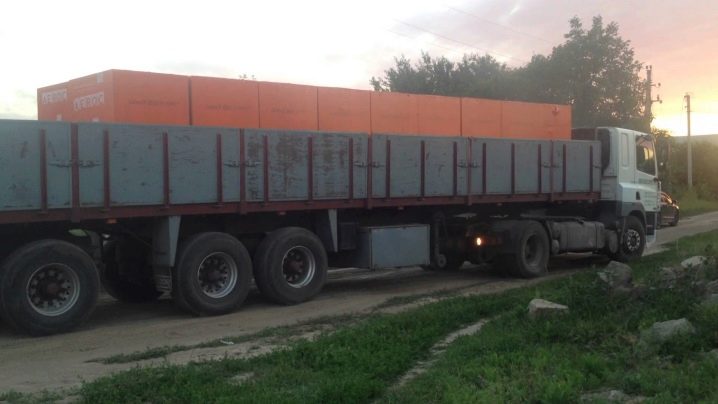
Many homeowners are wondering which materials are best to use for the exterior cladding of a gas-block house.
Currently, most often people turn to these options:
- brickwork;
- decorative masonry;
- ventilated facade;
- special plaster mixes.

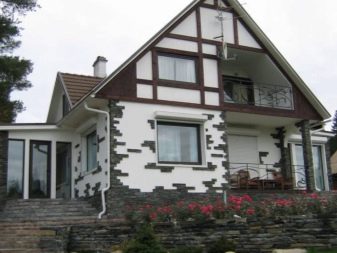
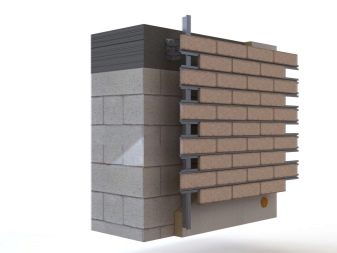
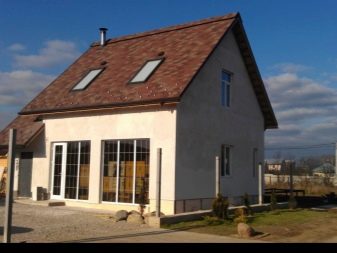
- When working with concrete mortar on hot days, remember that this material should be sprayed with water from time to time during drying. In this way, you will protect the concrete base from cracking.
- To make grooves in aerated concrete, you can use a grinder equipped with a diamond blade for dry cutting. Thanks to this practical tool, the grooves can be removed without any problems with the chasing cutter.
- To reduce the time required for the construction of a block house, it is permissible to use special U-shaped blocks as lintels over door and window openings. If you want to save money, then it is quite possible to make such parts with your own hands from a single gas block.
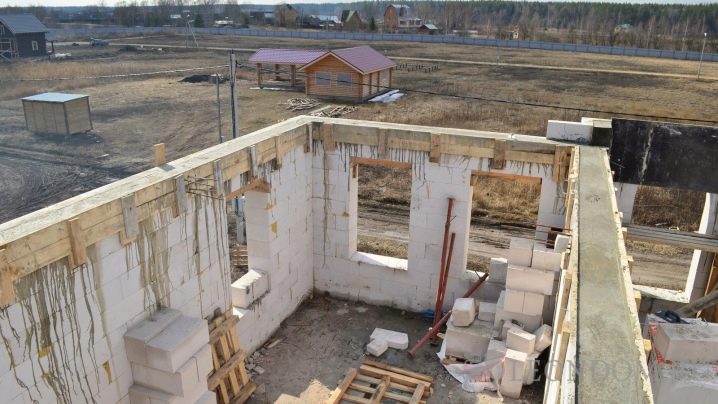
- Remember that the speed of construction work directly depends on how high-quality and neat the first row of aerated concrete masonry is. If it is laid out in accordance with the level indicators, then the installation of the remaining rows will not be difficult and will not bring problems.
- It is not recommended to lay aerated concrete blocks from two corners towards each other. Thus, it will be quite difficult for you to bandage the rows, as well as adjust the finishing piece to the required size.
- If you need to cut an aerated concrete block, then it is quite acceptable to use a simple hand hacksaw for this, however, experts advise giving preference to a more practical tool - an alligator saw, in which there is a canvas with victorious solders. With this device, you will save not only time, but also your own energy.
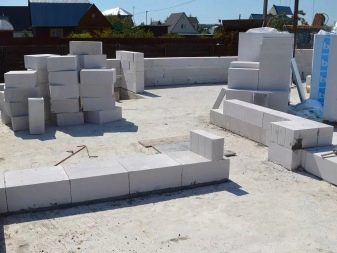
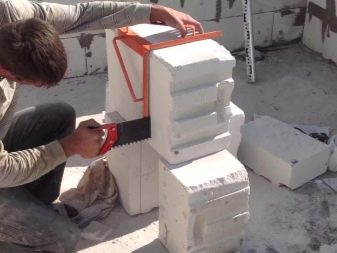
- To lift the blocks, it is recommended to use a homemade tool - a diamond grab. With such a device, it will be easier to lift and move building materials.
- Experts advise to carry out the installation of aerated concrete blocks using homemade scaffolding.
- Throughout all construction work, it is very important to constantly use the level. Most often, craftsmen choose the bubble or laser option. Don't forget about this tool - without it, it will be almost impossible to build a strong, attractive and stable home.
For information on how to quickly and cheaply build a house from aerated concrete, see below.













The comment was sent successfully.